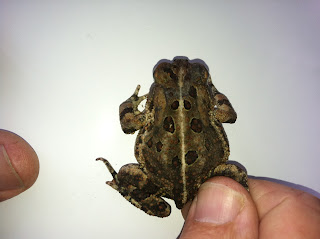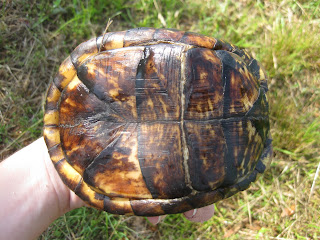Essentially my job for the summer is to help work on the Maryland Herp Atlas. The Herp Atlas is a survey that aims to measure what herps (snakes, turtles, lizards, frogs, & salamanders) exist in Maryland, and approximately where they exist. The last data that MD has on what herps are where is from 1975, which is to say, extremely outdated. In a nutshell I get to run around the woods looking for critters.
As it was, my first day I saw a Snapping Turtle as I was driving in to the Sanctuary. I was 15 minutes early, but ended up sitting there by myself for a good 30 minutes because my new boss, Chris, was a little late. I just made friends with Richard, the old maintenance man, who apparently knows my uncle. Weird.
Day 1 consisted of my intro the Sanctuary and a tour around some of the trails. I learned the difference between American and Fowler's toads, which is cool because I thought toads were only a single species.
 |
| Fowler's Toad, dorsal view |
 |
| Fowler's Toad, ventral view |
1. Fowler's Toads have more than 3 warts in each black spot
2. The ridge right behind the eye of the frog (it's about 90 degrees) nearly touches the eye on Fowler's Toads. On American Toads there's a wider gap.
3. American Toads have a very spotted belly
4. American Toads have large warts on their tibia.
 |
| Eastern Fence Lizard |
 |
| Snapping Turtles |
a couple cardinals
Acadian Flycatcher
Red-eyed Vireo
Summer Tanager
Ovenbird
Swainsons Thrush
Veery
Common Yellowthroat
Wood Thrush
Downy Woodpecker.
 |
| Swainson's Thrush (see yellow eye ring?) |
 |
| Eastern Wormsnake |
During our second round of checking nets, we realized that there was a fawn chillin' out right next to a tree we had been literally walking right next too. As soon as somebody said something, we scared her. She was so small that she wobbled about 20 feet away and nestled down in a downed branch.
 |
| Fawn (right in the center) |
 |
| Red-bellied Turtle & Box Turtle |
On our last check of the nets we came across a Box Turtle and a Red-bellied Turtle. What Chris (aka new boss) calls Red-bellied Turtles are actually better known as Red-bellied Cooters. He sort of admitted that he's uncomfortable with using the word 'Cooter', which I found somewhat amusing. Chris is the Director of the Sanctuary and he's a nice guy, but definitely has a bumbly air about him.
Day 3: Saw a large Red-belly digging a nest as I walked into the office. We notched it's shell (turtles have ~24 scutes on their shell that the Sanctuary notches in a special code so that people can fill out reports when they see a specific turtle) and gave a quick demonstration to a 3rd grade school group that was visiting. While letting the Red-belly go I came across a Box Turtle in the Meadow. Chris is something of an expert on Box Turtles and most of the ones in the Sanctuary have notched shells. The cool thing about Box Turtles is that the color patterns on their plastrons (the bottom part of their shells) are unique to each turtle, like reptile zebras.
 |
| Box Turtle from the Meadow |
 |
| plastron of Box Turtle |
Later in the day Chris and I started talking about what I wanted to research this summer. Every intern has to do a research project and I'm thinking about doing mine either on skinks or toads. In order to do research on skinks, you have to be able to catch them. If you've ever seen a skink or attempted to catch one, you know it's like trying to catch rainbows. Skinks are super shy and very skittish animals. One way to catch lizards in general is with a noose. Chris made me one so that I could go practice my noosing skills.
My practice noose is made with dental floss and a broken wooden pole from something or other. Very classy, truly. I then spent about an hour and a half down by the water looking for skinks to try and capture with my makeshift noose.
You creep up slowly and then VERY slowly bring the noose closer and closer to the skink and once you get the noose around it's neck, you pull up and enclose their neck in the noose. It doesn't hurt the lizard (very much, I don't think), and it certainly doesn't kill them. It just immobilizes them long enough for you to get your hands on one.
 |
| Mud Turtle basking in the bog |
 |
| 5-lined Skink in forest (failed at catching this one) |
I attempted to catch six skinks. I failed every single time. Noosing is a lot harder than I thought it would be. Apparently it takes a lot of practice.
At one point, I almost caught a Northern Watersnake in my noose, but another snake swam by and spooked the first snake. And then I stepped in the wrong place and almost fell into the bog, which would have totally sucked. As it was I submerged one of my boots and had to change into the spare sandals I kept in my car.
 |
| Spider from the sink |
Day 4: Chris had a meeting in Annapolis, so I spent the morning renumbering the mist nets and getting lost because they're not in order and there's no map to go by. One of the first things I saw was this giant ass spider chillin' out in the bathroom sink. Nearly had a heart attack because I just wasn't expecting it. I saw a bright red bird with black wings which I later found out was a Scarlet Tanager. Pretty distinct, that's for sure.
While I was renumbering a net particularly close to the water a Great Blue Heron flew right over my head while calling. Pretty cool stuff. I helped out on a nature walk with a school group (naming trees and stuff) and realized that it's kind of difficult to tell the difference between Maple and Sweet Gum leaves when I've never seen a sweet gum and they're both shaped like stars. Something to work on, I guess. One of the kids found a small Gartersnake in the roots of a tree, which was probably the coolest thing they'd ever seen.
 |
| Green Frog |
After lunch Chris and I drove to an old farm that the county had recently purchased to do some searching for the Atlas. It was a pretty untouched area with lots of life in it, but it was really hot (around 90 degrees) and most herps like it a bit cooler, so we didn't find much.
One awesome find was the Spotted Salamander we found hiding under a log. They're so chunky and cool lookin'.
 |
| Spotted Salamander (we put it on some moss for contrast) |
 |
| Gartersnake near roots of tree |
There hasn't been a Day 5 yet because Friday was a furlough day and tomorrow is Labor Day (Holla at my 4-day weekend!). I'm excited though, because the other two interns start on Tuesday. Weirdly enough they're BOTH named Holly. I hope they're cool.
In other news, my mosquito bite count for 4 days: 73. Ticks: 2. Even though I absolutely hate it, I think insect repellant might have to be a must.
No comments:
Post a Comment